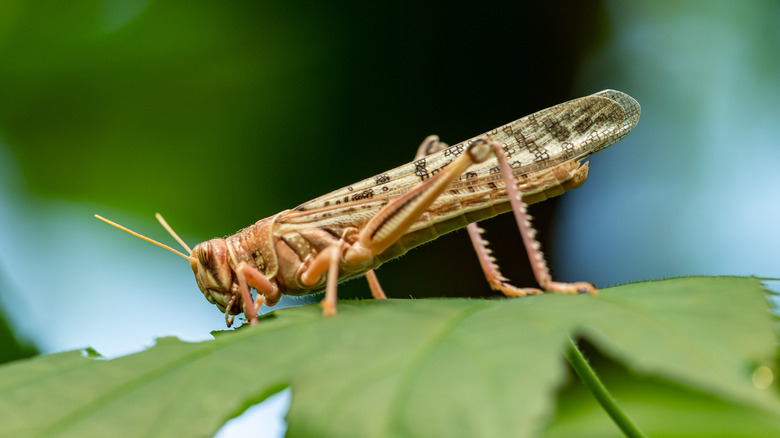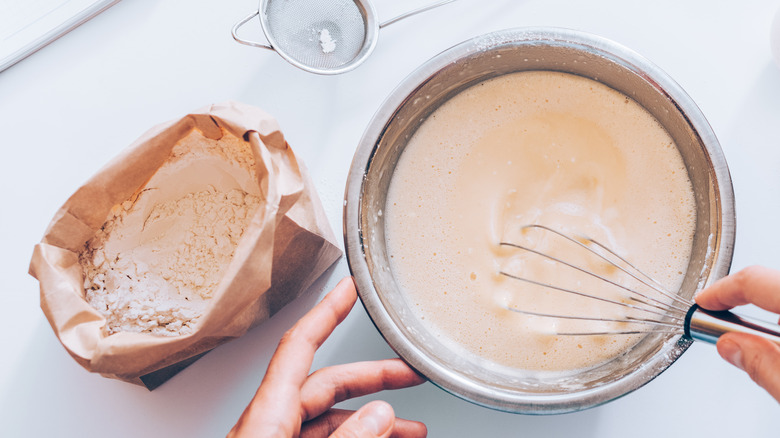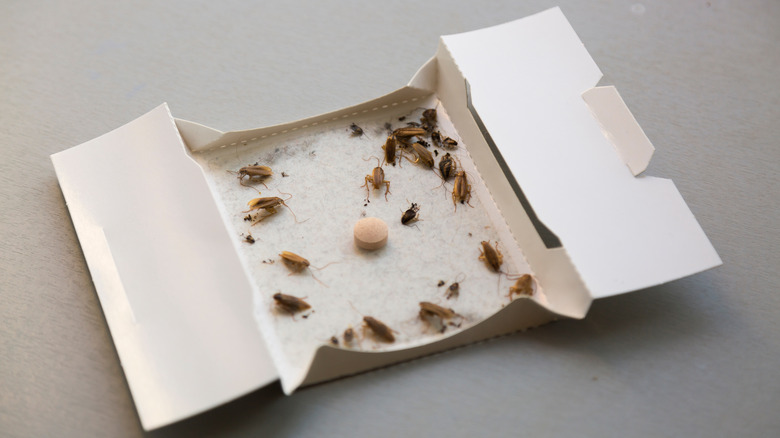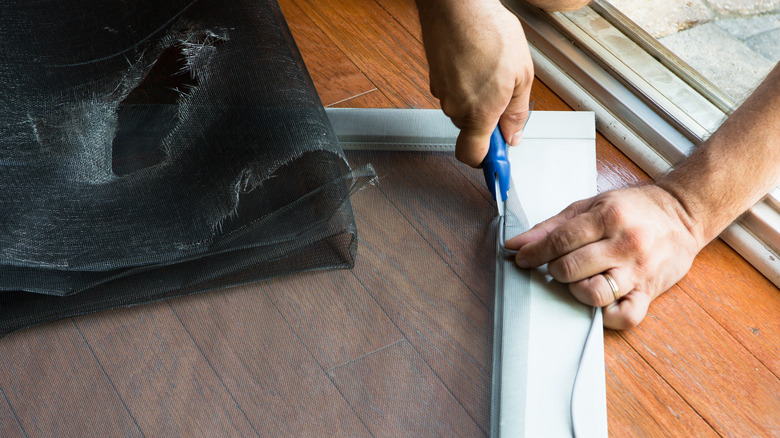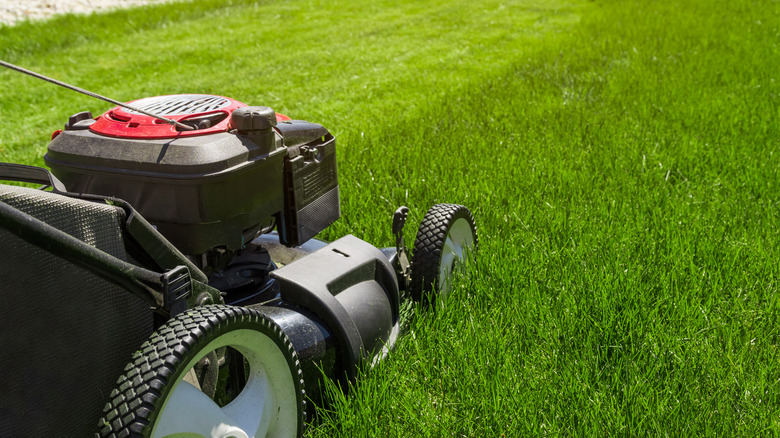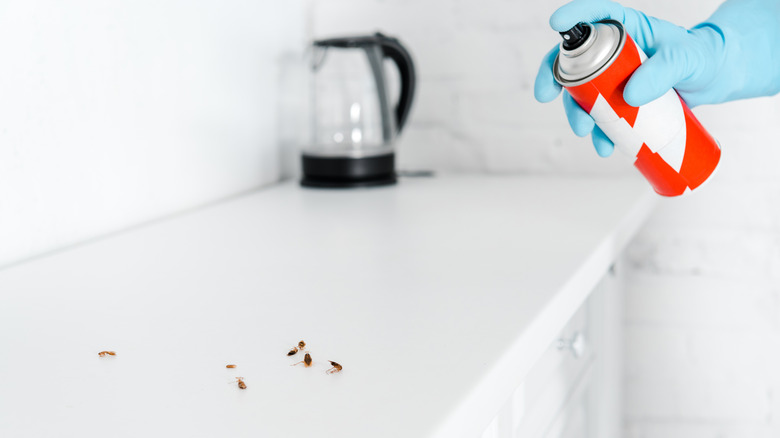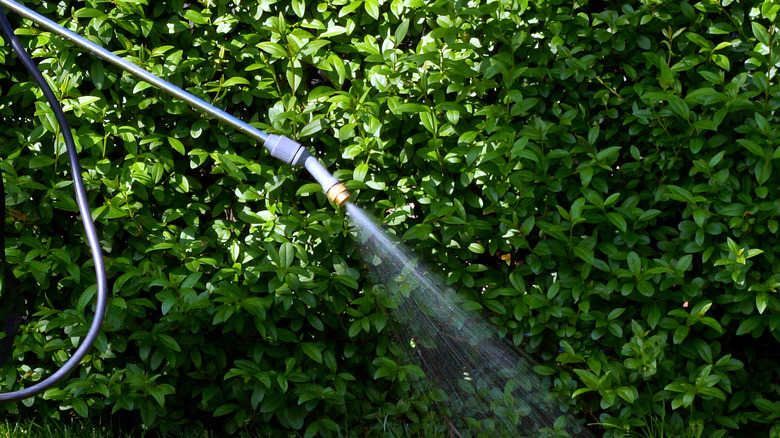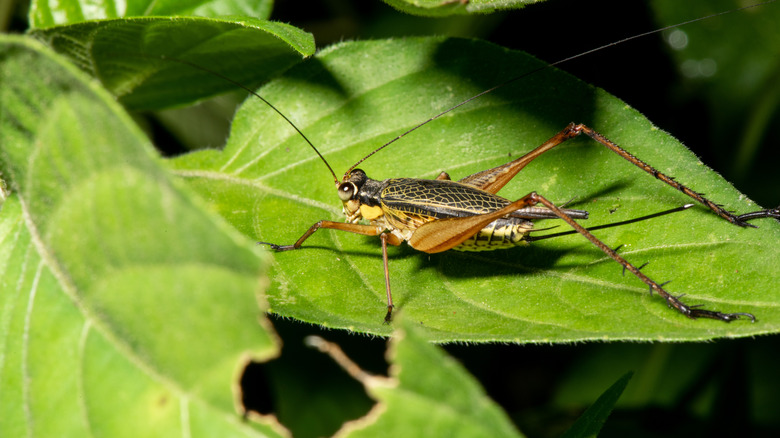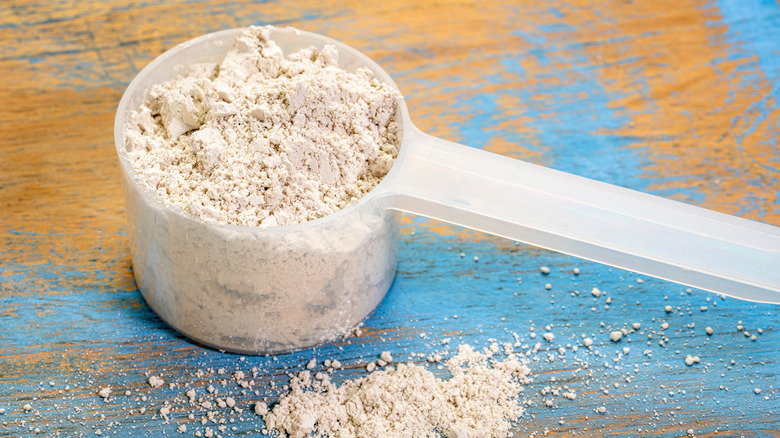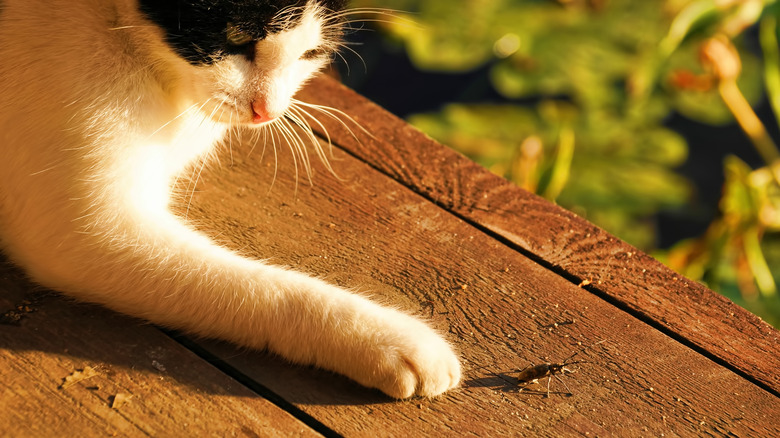12 Best Ways To Get Rid Of Crickets
We may receive a commission on purchases made from links.
While some critters might be more annoying (and downright nastier) than others — for instance, robins that invade your home can be a nuisance but are at least pretty, while centipedes in your house don't have much going for them at all when it comes to looks — crickets might seem to be somewhere in between. However, according to Pest Control Zone, crickets are actually an incredibly common problem when it comes to infestation and can do a heck of a lot of damage.
Attracted to your home thanks to conditions that offer them grassy areas, lots of plants, and of course, access into your home through nooks and crannies, crickets can not only make a lot of noise with their chirping, but they can also make a meal out of the materials that make up your home and décor (wood, fabric, wallpaper, rubber, leather, fur, etc.), bite humans, and even pass on diseases.
If you think you might be facing a cricket infestation, you can obviously confirm that by listening out for the distinctive chirping sounds they make. On top of that, Aptive Environmental explains that while seeing a cricket here or there is normal, spotting multiple crickets around your home might mean that something's up. You'll also know that you might be infested with crickets if you find materials that appear to be chewed up. If this sounds familiar, then keep reading to find out about the best ways to get rid of crickets.
1. Vacuum
If you have a cricket infestation, vacuuming can actually be a key tactic to get rid of the unwanted critters. To make your vacuuming as effective as possible, you'll want to look out for (and suck up) any live crickets you spot along with dead crickets and cricket eggs. If those eggs hatch — which can be thousands at a time, per Pest Control Zone — then you could end up more crickets than you could imagine living in your home. Although it might be easier to spot both live and dead crickets, to track down the eggs (which look like little gross grains of rotten rice), look in spots that are relatively hidden and in spaces between 80 degrees and 90 degrees Fahrenheit. Pest Advisors suggests looking in and around cracks in your walls, any kind of crevices, as well as spots around dark floors and anywhere that's moist.
Once you've found crickets or cricket eggs, Hunker points out that you should use a vacuum with secure attachments. You can even opt to pop some talcum powder into the vacuum prior to starting and after the critters have been sucked up to, er, end them off in a quicker manner. Then empty your vacuum into the trash and put it outside right away.
2. Homemade cricket bait
There's a chance that you may be hearing crickets in your home but haven't seen them quite yet. In that case, you can still jump on the problem by luring them out of their hiding places with homemade cricket bait. According to Home Pest Removal, your cricket bait can be as simple as bits of food that are rich in both sugar and carbs. For an option that's a little less cricket-friendly, they also suggest adding something like borax into your mixture — but beware of using this if you have pets or children around.
The Seattle Times offers a slightly more complex recipe and process for homemade cricket bait, but they pretty much guarantee that it will be effective. For this, you'll need 1 cup of water and 1/2 cup of sugar as well as 1/4 cup of bacon drippings, 1 onion, and 8 ounces of granular boric acid. After mixing the boric acid and flour together, chop up your onion and add it in before popping that into the bacon drippings (which you've let cool and thicken up) and sugar. Make balls out of what you've created and leave them in or on something that can stand up to the acid. Leave them for crickets to find, eat, and probably perish. But again, keep them away from kids and pets.
3. Pre-made cricket traps
Bug traps can help you capture and get rid of a number of different kinds of critters, which is why Elevate Pest Control offers instructions on how to make traps. While those ideas can definitely come in handy, not everyone has the time, patience, or ingredients to make their own homemade cricket traps or bug bait. That's why pre-made cricket traps exist. Working in the same way that cricket bait does — in that the traps first attract the crickets to a certain spot — they then make sure to keep the critters there for you to dispose of.
Most traps rely on sweet smells to attract the crickets and a sticky surface that doesn't allow the bugs to hop away. Just check out the peanut butter-scented Catchmaster Pest Trap, pesticide-free Harris Cricket Glue Traps, or Tomcat Household Pest Glue Traps, which can either be placed down flat or used as a covered trap so that you don't have to see what ends up stuck inside. Or, if you have a lot of crickets around, then you might want to opt for the Catchmaster Cricket XL.
4. Make your home less appealing to crickets
Once you've started to get rid of the crickets that have already made their way into your house, then you can do what's necessary to prevent more from getting inside. To do this, you'll want to make your residence a place that isn't terribly appealing to the pesky bugs.
First, you'll want to patch, seal, or cover any holes or cracks that crickets might be using to get into your home. You'll also want to do the same for places where they were living or laying eggs. The DIY Network explains that you'll want to look out for and address any cracks in walls, splits in siding, and holes in windows and door screens as well as vents. How Stuff Works also notes that you'll want to make sure that any garbage or compost bins around your home have a lid on them. Beyond that, be sure that both your kitchen and eating areas are kept clean of crumbs.
5. Deal with your yard
In the same way that you want to make the inside of your home a place that crickets simply aren't interested in, you'll want to make your yard less appealing to them as well; Bob Vila explains that means addressing or getting rid of things that might attract bugs.
To that end, you'll want to remove the natural aspects of your yard that are ideal for crickets. Be sure to keep your grass mowed short and bushes trimmed while also pulling out weeds so that crickets aren't able to hide in any of those places. Scott's Lawn Care, Inc. adds that you'll need to regularly turn over any mulch in your yard and move woodpiles away from your house and off the ground. The Spruce backs that up while also explaining that in order to prevent bugs from making your woodpiles their home, you should also keep the logs away from trees, but they should never be kept inside.
6. Indoor spray
When it's time to get a little more hardcore, then you might need to use a spray to get rid of crickets. According to Hunker, many kinds of bug spray use pyrethrins or pyrethroids which are chemicals that cause bugs to freeze up before dying. They tend to be both quick and effective.
Although companies don't often make a spray that's specifically for crickets, many options target a range of pests. Depending on your needs and preferences, you could opt for something that can be sprayed in problem areas like Ortho Home Defense Max Indoor Insect Barrier. If you need something that gets into the nooks and crannies, you could grab Ortho Home Defense Insect Killer for Cracks & Crevices. If you'd rather something that's more natural, you could check out Orange Guard 101 Home Pest Control, which takes advantage of ingredients that the FDA has deemed safe, meaning that it can be used around both humans and pets.
Whichever you think will work for you, be sure to target areas where you know crickets have been, spots where you suspect that they might be, and places where they could have laid eggs.
7. Outdoor spray
After spraying for crickets inside of your house, you'll then want to head outside to do the same. For this job, you'll also want to choose a spray that can handle the outdoor conditions, such as Ortho BugClear Insect Killer for Lawns & Landscapes or Cutter Backyard Bug Control. If you're looking for something more natural, then you might want to try mdxconcepts Ready-to-Use Outdoor Pest Spray.
Maggie's Farm Products has some helpful tips on how to use outdoor spray safely and effectively, noting that you should first read the specific instructions for the product that you're using. Also, use the spray when it's cooler so that your plants don't burn, apply the spray at the base of the plants, and sweep your arm from side to side as you spray each area. They also note that fall is a good time to target crickets due to the fact that it's right before they may want to get inside of your warm home to avoid spending the cold winter outside.
8. Reduce heat and moisture
According to Hello Homestead, crickets prefer environments with an ideal temperature of 85 degrees and about 50% humidity. If you want to make your home unwelcome to crickets, use a dehumidifier. This will reduce the moisture in the air and also help prevent mold and mildew (via Angi). Also, try to lower temperatures in your home to drive crickets away. Living areas are likely closer to room temperature, but the heat can creep up in places like garages and attics. Portable air conditioners can be used on hot or humid days to keep these spaces cooler and drier.
Another source of excess moisture is leaky pipes and outdoor seepage (via U.S. Environmental Protection Agency (EPA)). This can cause water to settle anywhere from crawl spaces to bathrooms. Regularly examine visible pipes for signs of leaking or condensation. Ensure that they are adequately sealed and that any leaks in the roof or ceiling are addressed by a professional. Make sure crawlspaces have proper ventilation and remove any organic materials that can harbor moisture.
9. Choose garden crops intentionally
Your garden cannot only provide you with a yearly harvest, but it can also give you another strategy to deter pesky crickets. Bio Pests Organic Pest Control points out that crickets don't love munching on flavorful plants and crops. So, fill your garden with varieties of onions and garlic. Potent herbs like rosemary and thyme are also good options and make great container plants that you can also grow inside. Crickets are also irritated by plants that hold nitrogen in their roots. These include green beans, soybeans, and sweet peas — all great garden staples (via Rural Sprout). A row of nitrogen-fixing red or white clover creates a colorful border to your plot and can make a barrier for crickets.
However, there are some plants that you can steer clear of to avoid creating a cricket-friendly feast inadvertently. The insects love a wide variety of vegetables, including squash and leafy greens (via WebMD). Underground crops like potatoes and carrots are also a part of a healthy cricket diet. They also enjoy fruits like apples and oranges, so make sure to pick up any fallen fruit.
10. Use diatomaceous earth
According to the Farmers' Almanac, diatomaceous earth is a powder made from ground-up fossils that is an effective way to kill insects. Purchase a food-grade version of the substance for a safe way to rid your home of crickets. The powder is abrasive and scratches the surface of the insect's exoskeleton, so they dry up and die off.
To use this method to rid your home of crickets, pick up a bag at your local hardware store (via Essential Home and Garden). It's a good idea to wear a face mask and gloves when applying the powder to avoid irritating your lungs or drying out your hands. Sprinkle the dust on any surface that you suspect the crickets frequent and allow it to sit. After a couple of days, clean the powder with a vacuum or wet cloth.
Diatomaceous earth is also an effective way to rid your landscaping beds and the areas around your home of crickets. You can mix a few tablespoons into a gallon of water for a sprayable version of the natural insecticide (via Trees.com). Apply to garden plants and create a deterrent border around your home. Keep in mind that the solution will only work when it's dry, and you may have to apply it regularly for long-term cricket control.
11. Recruit some help from animal friends
Your furry family member can be an effective way of ridding your home of crickets. Senior Cat Wellness explains that cats love to prey on moving insects, including crickets. Use these instincts to your advantage and allow your cat to chase and kill any crickets they find in your home. Plus, if they eat the crickets, they are actually a healthy food choice. They are a good source of iron, protein, and fatty acids — all essential to your four-legged friend's health.
You can also draw wild predators to your yard to solve your cricket problem. Starlings, bluebirds, cardinals, and sparrows all feast on the chirpy insects (via Chirp Nature Center). So hang a feeder and look for packages of bird seed mixes to attract these species. Bats like to eat crickets as well. They can also help reduce the populations of other harmful insects like mosquitoes. Hang a bat box in your yard and plant night-scented flowers like jasmine to create a welcome home for these cricket predators.
12. Get professional help
Depending on how many crickets have found their way into your home or how hard they are to reach, you may not be able to deal with the problem on your own. Elevate Pest Control also points out that some critters are just too hard to get rid of without professional help, and might even be too dangerous to tackle without the proper know-how and equipment.
When you bring in someone who works in professional pest control, they'll be able to assess your particular situation and come up with the best plan of action. While some tactics will be more intense than others — such as simply setting up strategically placed traps compared to having to leave your home for a few days so that it can be fully fumigated — you and the company you've chosen to work with can figure out what suits you best and what will definitely rid your home of crickets.
